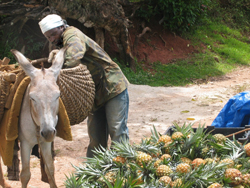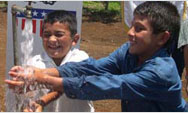You are here » Home » Telling Our Story
Success Story
New techniques are producing bigger, better fruit
Pineapple Farmers Reap Big Profits

| |
Photo: GRW Management Committee/Neville Williams
|
|
Jamaican farmer Outie Auchope loads his crop in Ginger Hill, St. Elizabeth, near one of the demonstration plots where farmers are learning special planting techniques.
Production from this year’s pineapple harvest is expected to double for farmers using the new techniques.
|
Jamaicans have been growing pineapples ever since they can remember. Starting with the island’s first inhabitants, the Taino Indians, pineapples have been a way of life.
The Great River Watershed in western Jamaica is a fragile ecosystem that is home to thousands of people and businesses. Ninety percent of all pineapples grown in Jamaica come from this region, putting tremendous pressure on the environment. Over the last two decades, over-farming and traditional farming techniques resulted in unhealthy plants. Pineapples became smaller and less sweet. As their quality declined, local processing companies and hotels started to look elsewhere for pineapple supplies.
In 2004, USAID introduced a new initiative to improve pineapple production while protecting the delicate balance of the watershed’s ecology. Using demonstration plots, the program taught better agricultural practices to 130 farmers, like rotating land use, using fertilizers and insecticides, and regular replanting. With techniques like spacing, which allows farmers to grow other crops between pineapple rows, farmers are making more money. In addition, spacing helps to conserve soil and control weeds.
The effort has resulted in better-tasting and bigger pineapples. As word has gotten out about the sweet, high-quality pineapples these farmers are growing, demand has increased. The farmers have planted 60 extra hectares of pineapples, and are expecting to double production during the 2006 pineapple harvest. New types of pineapples, like the rare and sweet “Smooth Cayenne,” will be introduced so there will be greater variety to domestic pineapple production. This should also boost the Jamaican market’s competitiveness.
Jamaican farmers in the Great River Watershed cannot imagine growing anything other than the pineapples their parents, grandparents, and ancestors grew. With USAID’s help, farmers are able to protect their livelihood, their environment, and their island’s agricultural traditions.
Print-friendly version of this page (455kb - PDF)
Click here for high-res photo
Back to Top ^ | 

